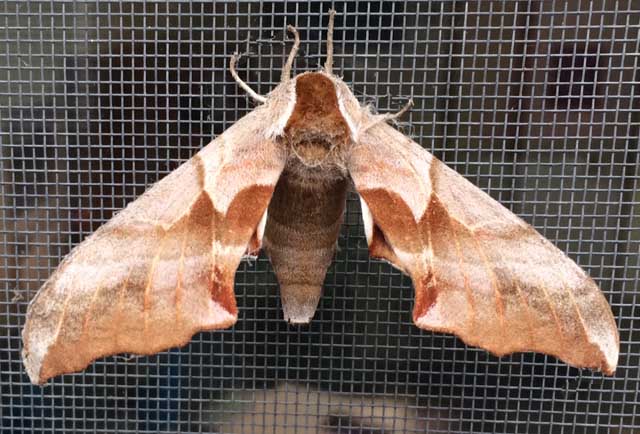Humboldt County, Northern California, and
Trinity and Mendocino Counties
Sphingidae

|
|
Created/dedicated as per personal communication with Gayle Garman, August 17, 2017 Updated as per James P. Tuttle's The Hawk Moths of North America, August 17, 2017 |

Gayle writes, "I took this photo outside my office window at the edge of Fortuna, CA in Humboldt Co. The moth has been on the screen since yesterday morning. It moved its wing when I tried to pull away some spider web from its leg.
"It looks like the pictures of the Smerinthus saliceti. But it is on the screen of my office window in Fortuna, CA (Humboldt County).
"Any thoughts?"
I reply: "Hi Gayle, Thanks for thinking of me. Smerinthus saliceti is a good match by appearance, but saliceti would not occur so far north in California. This one is much more likely Smerinthus ophthalmica , and I will post it as such, credited to you, on Humboldt County page that I will very shortly create. Will send you the link once I have done that.""
It is hoped that this checklist, with the thumbnails and notes, will help you quickly identify the moths you have encountered.
Please help me develop this list with improved, documented accuracy by sending sightings (species, date, location), preferably with an image, via email to Bill Oehlke.
Sphinginae subfamily
Smerinthini Tribe:
Macroglossinae subfamilyDilophonotini Tribe:
Philampelini Tribe:
Macroglossini Tribe:
|
Use your browser "Back" button to return to the previous page.
This page is brought to you by Bill Oehlke and the WLSS. Pages are on space rented from Bizland. If you would like to become a "Patron of the Sphingidae Site", contact Bill.
Please send sightings/images to Bill. I will do my best to respond to requests for identification help.
 Show appreciation for this site by clicking on flashing butterfly to the left. The link will take you to a page with links to many insect sites. |